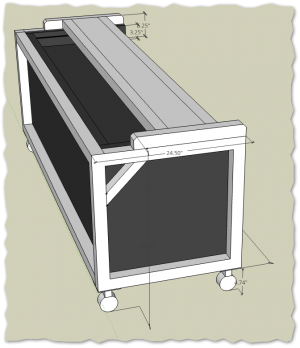While I wait for my PM-1236T, I've been planning my workstation/stand.... all this is inspired (copied) by designs previously shown on HM (primarily @davidpbest design) ... thought I'd share my take. Tell me where I'm going wrong or missing something!
Objectives
Caster/Levelling feet choice at the moment
The levelling threaded rod is 16mm.. but I've seen you can get these with a 24mm levelling threaded rod. Their just very expensive, $110/caster. Once the caster if off the floor, it's just like a threaded leveling foot, but you are 5" off the floor so the larger rod the better.
Objectives
- Strong and sturdy
- Ample storage underneath for accessories
- Targeting 48" to 50" lathe spindle center line height, that should put cross slide handle (center) around 42-44" from
- Moveable as needed
- Plan to use heavy duty levelling casters (when levelled, casters are off the floor)
- 2nd thought was to just have fixed levelling legs and build separate dolly w/casters for each end... jack up, slide underneath, move and remove when done.
- Buy the U.S. General 72" top tool chest from Harbor Freight and build the stand around it.. like others,
- It seems most others have used the shorter 56" version and just place on the bottom shelf of their stand... I'm going for a more integral setup, neither better or worse (well, worse is up in the air
.
- The BIG question is what color box... red or black?
- It seems most others have used the shorter 56" version and just place on the bottom shelf of their stand... I'm going for a more integral setup, neither better or worse (well, worse is up in the air
- Frame around tool chest will be 2" square aluminum tubing all welded together (it's what I have plenty of).
- Tool chest won't really carry any weight, all that is transferred through the main frame.
- Tool chest flip up top lid comes off and area for pull out chip pan. There's about 3" height, so more than needed but also lots of easy access to.
- Do not plan to use the included chip pan
- Not sure about the splash guard, though, likely will be installed and used for swarf containment as well use accessorized with holders for common/quick access tooling
- *IF* I ever convert to 3 phase and need a VFD or oiler system, the left bank of drawers can come out and that opens up a cavity for electronics... or all that stuff goes over head.
| I'll turn this... | into this... (excuse my beginner 3d skills in Sketchup) |
|
|
Caster/Levelling feet choice at the moment
The levelling threaded rod is 16mm.. but I've seen you can get these with a 24mm levelling threaded rod. Their just very expensive, $110/caster. Once the caster if off the floor, it's just like a threaded leveling foot, but you are 5" off the floor so the larger rod the better.
| I figured these weights Lathe: 850 lbs. Tool Chest (empty): 350lbs Frame: 200 lbs. Tool Chest (loaded stuff): 500 lbs. (pure guess) Total Static Load is: 1,900 lbs. Casters rated at 2200 lb. / caster. Theoretically, 8,800 lb for 4. |






